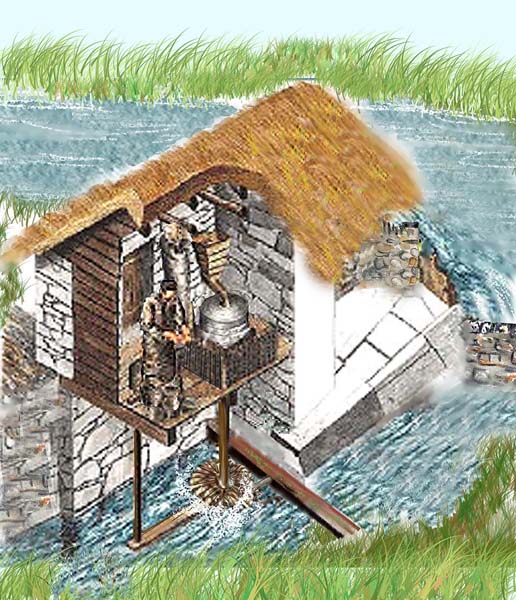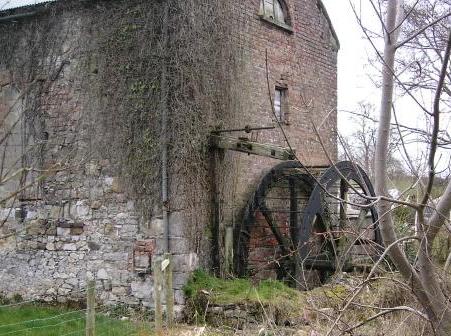|
|
Water Power in Ireland.Water
Power Calculation | Working
Water Wheels |
|
| |
|
Read about Corn Mills and Querns from 'A Smaller Social History of Ancient Ireland' by P. W. Joyce It is thought that the horizontal water wheel came to England from China around 1 AD, it was then brought to Ireland by the monks, who often incorporated water mills in or near their monasteries. Monks at Nendrum County Down built a tide powered mill the remains of which were excavated in 1999 and were subsequently dated to AD 619, it is thought this was the earliest tide mill in Europe. In the twelfth century monks at Assore Abbey in Donegal also installed a water wheel, a mill built by St Fechin. near Fore Abbey in County Westmeath sometime in the 7th century is still in operation. Prior to the introduction of the potato
in the mid 16th century grain and meat were the mainstay of the diet,
it seems likely that the number of mills in operation then was significantly
more than existed even in the mid 1800's. In William E Hogg's book 'The
Millers & The advent of the linen
industry resulted in the building of probably hundreds of water powered
mills, there was hardly a river in the north east of the country where
linen production was densest, that did not have a wheel or turbine installed
at every suitable location The mid 1800's is probably when this development
was at its height, at around Water power was utilized for many purposes in the linen process there were scutch mills, these had rotating blades similar to fans which beat the fiber's from the wretted (rotted) flax stalks. Next the fibers were spun into threads which were woven into cloth and finally the cloth was beetled, see Wellbrook Beetling Mill The grinding of grain for both animal and human consumption was the main use to which water power was put. There were many of these mills dotted around the country, the vast majority of which no longer exist, although some remain abandoned and forlorn, such as the image above from County Monaghan. The Doomsday Book compiled shortly after the invasion of England in 1066 by William of Normandy "William the Conquer" lists 7,000 water mills in England, we can only assume that Ireland proportionately had as many. The grain was ground between to cylindrical stones about four ft in diameter and perhaps six to eight inches deep, the top stone rotated while the bottom remained stationery, the grain was fed into a hole in the center of the top stone and exited around the outside, the gap between the two could be adjusted with the tentering gear, which narrowed the gap resulted in finer flour. This was simply adapting the quern stone principle that had been used for centuries before the Christian's era. On the Orkney Island north of Scotland an example of an early horizontal mill survives, this is on Harray Island (I think) the technology was probably brought to Orkney by the Vikings. The horizontal mill consisted of a vertical shaft to which blades were attached a stream of water was directed onto the blades causing the shaft to rotate driving the top stone, the mill at Nendrum in County Down would have been this type. Most mills had two pair of stones, although some had three one such was Dyan Mill in County Tyrone, which was restored (unsympathetically) at very considerable cost to the tax payers with the declared intention of opening it to the public as a working mill, which would have been difficult to achieve as the water supply to the mill had been diverted many years previously. Today the taxpayers of Northern Ireland who presumably supplied the majority of the funding for this venture can indeed see the building, they can even gain access without charge, as it is now (2006) a furniture showroom. There are several operational corn mills open to the public one such is Castleward Mill and Annalong Corn Mill in County Down both mill are run occasionally for demonstration purposes, there are many more water mills in the southern counties. By the early 1950's few corn mills survived, in Maghera near Newcastle, County Down the mill owned by Paddy Fitzpatrick, who also had a pub and grocery shop in the village, needless to say the pub still survives, the mill was in operation about 1952, sadly it was demolished and a housing development now occupies the site. When the mill came on the market representations were made to the National Trust urging them to purchase and restore it, their reply, understandably was that they had a working corn mill at Castle Ward, some fifteen miles distant. A corn mill owned by Mr. George Holmes of Mill Farm Tollymore Co Down was in ways ahead of its time, in the early 1900's when the local town of Newcastle had not yet been connected to the mains supply, George installed a 250 volt DC dynamo which supplied electricity not only for the farm but several houses in the locality. Additionally he was able to charge the old glass cased lead acid batteries used in early radio sets for his neighbours. George died in 1965 his generator still in operation, in the late 1960's the waterwheel badly in need of repair was removed and a turbine installed by his son William. With the advent of the third generation all lies abandoned with thousands of potential kilowatts flowing past the farm each year lost through lack of vision and endeavor. In the year 1879 a waterwheel was installed at Birr Castle County Offaly, this wheel drove a generator which charged a bank of batteries which supplied electricity to the castle. Read about this on Birr Castle web site. Water power was put to many other
uses, The largest wheel ever built in Ireland was at Saggart in the Tallaght area of Co. Dublin, it was used to power a paper mill and was 24.38 m (80 feet) in diameter, there was a wheel 70ft (21.34 ) in diameter erected at Darlkey Co Armagh in 1852, although we have only read this in one source, and are therefore not really sure about that one. Ireland's first hydro-electric plant, was developed in 1883 at Portrush in Ireland. In the latter years of the 19th century water turbines came into use many of these replace the earlier water wheels, a local company Robert Craig and Sons of Belfast had installed 35 of its turbines by 1920. In the 1960's when the linen industry was declining there were 20 turbines in operation on the river Maine in County Antrim, we can only assume that other rivers such as The Six Mile Water, the Blackwater, the Callan, the Clady, the upper Bann, the Mourne and other rivers in Northern Ireland were utilized to the same extent.
|
|||
|
|
| Canyon Hydro 5500 Blue Heron Lane Deming, WA 98244 USA Tel 1-360-592-5552 E Mail Web Site |
Canyon Hydro. Canyon Hydro produces highly efficient, reliable turbine systems for generating hydroelectricity. They manufacture a wide range of small hydro systems up to 15 megawatts, and provide custom design and machining for new or replacement turbine components. On their site you will find useful data and formulas
relating to water power. Remember a US gallon and an Imperial gallon are
different. Use the script below to calculate the power available from a stream.
|

 The Mills of Ireland of About 1850' he lists some 3,500 mills from that
period, and states that many more probably existed, which had been missed
by the valuers. Mr Hogg must be congratulated on compiling and preserving
in one volume, information that had been previously stored in many historical
archives across the country, this labour of love must have consumed many
thousands of hours.
The Mills of Ireland of About 1850' he lists some 3,500 mills from that
period, and states that many more probably existed, which had been missed
by the valuers. Mr Hogg must be congratulated on compiling and preserving
in one volume, information that had been previously stored in many historical
archives across the country, this labour of love must have consumed many
thousands of hours.  1850
a wheel 21.4 Meters (70 ft) in diameter was installed at
1850
a wheel 21.4 Meters (70 ft) in diameter was installed at